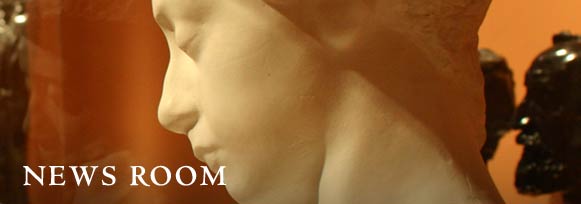Professor Documents the Emotional Effect of Chopin’s Music
A Faculty Focus: Where Is Chopin? By Jaroslaw Kapuscinski
February 20–March 3, 2013
Stanford, California —
Stanford music professor Jaroslaw Kapuscinski grew up steeped in Frederic Chopin’s music. He trained as a classical pianist and composer in Chopin’s hometown of Warsaw and constantly encountered Chopin’s music outside of school, too. “Chopin is clearly the most treasured composer in Poland,” he says. That experience prompted Kapuscinski to create Where Is Chopin?, a 31-minute, three-channel visual projection wherein Kapuscinski contemplates Chopin’s 24 Preludes along with the emotional reactions of varied audience members from 12 cities around the world.
This intermedia installation, running continuously at the Cantor Arts Center February 20 through March 3, mixes Kapuscinski’s recompositions of the preludes with elements from the original scores. The music emits from a grand Disklavier piano positioned near three screens, and on these screens people filmed in a portrait style react to the music, often with rapture. Kapuscinski found his subjects in Tokyo, San Francisco, Mexico City, Sydney, Seoul, Beijing, Istanbul, Jerusalem, Helsinki, Buenos Aires, Wellington and Santiago, and he collaborated with local photographers or cinematographers in the filming. Kapuscinski wanted great variety in his listeners so as to better study the psychological, perceptual and cognitive processes of music. The project seeks to demonstrate “how emotions emerge from music, how musical structures are interpreted, and what they mean to different people,” he says.
To Kapuscinski himself, Chopin’s music has a “profoundly political and historic” meaning, since in Poland under Nazi occupation the penalty for playing Chopin’s music was death, he says. “My professors participated in underground Chopin recitals.” Kapuscinski also considers Chopin’s work “the vehicle to transmit what ultimate art and beauty are.”
Where Is Chopin? works as a vehicle of art and beauty too, given its poignant subject of human emotion and the entrancing medium used for capturing it.
Presentation of this project at the Cantor Arts Center is made possible by a grant from the Drs. A. Jess and Ben Shenson Funds. This project was commissioned jointly by the WRO Art Center, the Warsaw Autumn Contemporary Music Festival and Stanford University for the 2010 Chopin Anniversary Year and was co-funded by the Polish Ministry of Culture and National Heritage and the Polish Cultural Institute in London.
The Cantor is open Wednesday–Sunday, 11 a.m.–5 p.m., Thursday until 8 p.m. and is located on the Stanford campus, off Palm Drive at Museum Way. Admission is free. Parking is free on weekends and after 4 p.m. weekdays. Information: 650-723-4177, museum.stanford.edu.
Visitor information
The Cantor Arts Center is open Wednesday–Sunday, 11 am–5 pm, Thursday until 8 pm. Admission is free. The Cantor is located on the Stanford campus, off Palm Drive at Museum Way. Parking is free after 4 pm. weekdays and all day on weekends. Information: 650-723-4177, museum.stanford.edu
# # #
Notes to editors:
• To arrange interviews and for further information, contact Anna Koster, Head of Communications, Cantor Arts Center, 650-725-4657, akoster@stanford.edu
• For high-resolution publicity images, contact PR Assistant Manager Margaret Whitehorn, Cantor Arts Center, 650-724-3600, mmwhite@stanford.edu
About the Cantor Arts Center
Take a journey around the world: from Africa to the Americas to Asia, from classical to contemporary. There is so much to discover at the Cantor. With 24 galleries plus sculpture gardens, collections that span 5,000 years, a world-famous Rodin collection, changing exhibitions, frequent tours and free programs, there is something for everyone at the Cantor. And admission is free for everyone.
About the Artist
Jaroslaw Kapuscinski is an intermedia composer and pianist whose work has been presented at New York's MOMA, Zentrum für Kunst und Medientechnologie in Karlsruhe, the Museum of Modern Art Palais de Tokyo in Paris, the National Reina Sofia Museum in Madrid and many other venues. He has received awards at the UNESCO Film Sur l'Art Festival in Paris in 1992, VideoArt Festival in Locarno in 1992 and 1993, Manifestation Internationale Vidéo et Art Éléctronique in Montréal in 1993 and International Festival of New Cinema and New Media in Montréal in 2000. Kapuscinski creates and performs works in which musical instruments are used to control multimedia content. He was first trained as a classical pianist and composer at the Chopin Academy of Music in Warsaw and expanded into multimedia at a residency at Banff Centre for the Arts in Canada (1988) and during doctoral studies at the University of California, San Diego (1992–1997).
Kapuscinski is actively involved in intermedia education. Since 2008 he has been Assistant Professor of Composition and Director of the Intermedia Performance Lab at Stanford University. He has taught at McGill University in Montreal, the Royal Academy of Arts and Music in the Hague, the Art Conservatory and Music Academy in Odense and the Conservatory of Music at University of the Pacific.
Kapuscinski speaks about "Where Is Chopin?" on Thursday, Feb. 21 at 5:30 & 7:30. Learn more

A Tokyo audience listens to Jaroslaw Kapuscinski's performance of Chopin's Preludes Op. 28 (detail). Photo: Bruce Osborn



